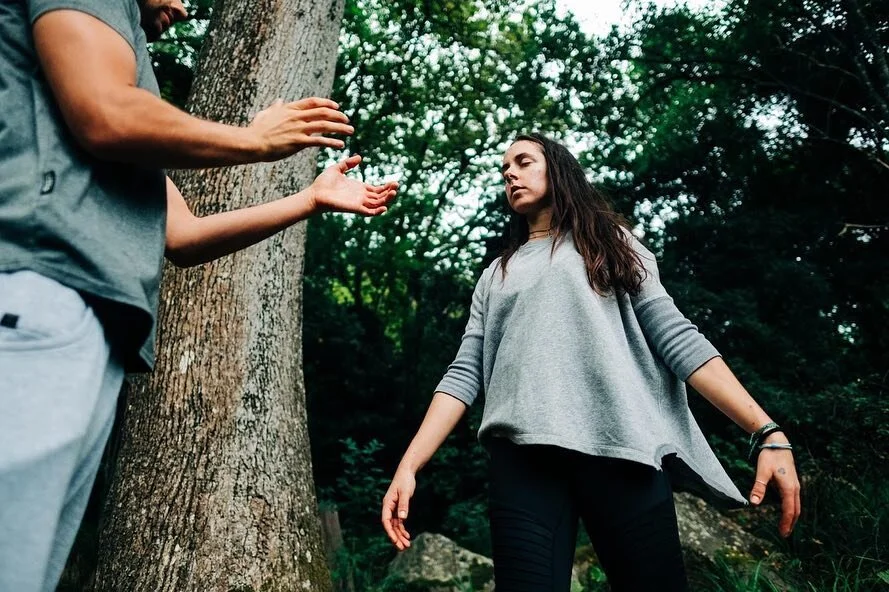What Plant Medicine Taught Me About Eating Disorders And Attachment
In all of my medicine journeys, I have never been shamed by a plant. But have they given me the honest truth? Yes. Whilst I’ve never been punished or shunned by a sacred plant ally (which is something I am often on the lookout for… a deep conditioning), I have been brought to my knees at the amount of work that still needs to be done and that the work must be done; and I have been reminded that this work is the most rewarding work there is - and that the plants are there cheering me on.
Fun fact: I have gone into many psychedelic journeys thinking I would be punished for not doing my integration “homework”, or for showing up unwelcomed.
Fun fact: I have never been put into the naughty corner or told to leave.
The plant world is filled with beings who are pure. And with this purity, they are of course honest. So they have shown me the hard facts of how I am living, but always delivered with unconditional love. I have learnt so much through plant medicine about attachment, bonding and boundaries. I am grateful for these beings for sharing this wisdom so generously in the name of consciousness expansion.
When working with the plants, I almost always come up against some part of my eating disorder behaviours that needs to be examined. I used to think that since I often am working with eating disorder-related stuff, I would be punished for “not having done my homework.” This pattern is based on fear, specifically fear of not being good enough, and that in order to be loved, and in a safe attachment, I have to perform in a certain way - otherwise I am not loveable.
This is a classic trauma response: we have to adapt, suppress, reject a part of ourselves in order to comply with what we perceive our caregivers to deem important. And so, throughout my life, I have morphed myself to perform in an acceptable way - even if it went against what I valued, cared about, or felt I had the energy for - in order to stay connected to loved ones.
Attachment style lives in our nervous system. It’s not something that can always be rationalized. It is development through a co-regulation feedback loop with our caregiver. Based on the feedback we receive, we develop secure attachment (like an anchor), or become an island (aka avoidant), rejecting connection out of fear of being swallowed, or we become the wave that easily and ambivalently merges, fears being abandoned, and does not know where they stand (thank you to Kimberly Ann Johnson for imparting this metaphor).
When with the plants however, I have shown that however I show up, I do not have to fear punishment for not being perfect. The plants can see that I have been putting in the work, because they see the smallest of steps, including the big ones. Whilst the urge me on, they are content to go along at my pace and meeting me where I am at.
These experiences have been powerful in helping me reevaluate how I am in relationship, and how the conditioning from my parents and the environment around me have shaped how I am when connecting with others, especially in those more intimate spaces.
The connections we have with our caregiving attachment figures shape the structure of our brain in ways that can free us or imprison us. Indeed, the emotional quality of our earliest attachment experience is perhaps the single most important influence on human development.
There is enough empirical support now that early childhood experience is powerful in shaping and impacting development. Infants are attached to their caregivers not because caregivers feed them (whilst that is of course nb), but because caregivers trigger the unfolding of infants' inborn disposition to seek closeness with a protective other. We are wired for connection. According to leading neuroscientist and mindfulness teacher, Dan Siegel, he says that before we even had language and conceptual tools to process what we were experiencing as children, patterns of interaction were incorporated in the brain. These patterns - positive, negative or traumatic - impacted our psyches and even the molecules that control the expression of genes. He continues to say people can get "lost in familiar places" as they continually recreate their earliest patterns of interactions across the lifespan.
Indeed, these early relationships provide the foundation for personality development, but they do so by affecting the child's capacity for emotional regulation and the formation of mental representations of self and others, impacting one’s worldview and beliefs. For example, a child who has been rejected is likely to interpret the behavior of others as rejecting and behave in ways that lead to further rejection, continuing the pattern. It also seems that people end up treating those with secure attachment with warmth, whilst those with avoidant attachment are treated with more hostility and those with avoidant are controlled more and unduly nurturance. It seems then that the reflections happen in many directions.
I have come to understand that when working with psychedelics, we are able to change these structures through neuroplasticity. Psychedelics have the possibility to bring awareness to these patterns and alongside an integration coach, create new pathways for people to take as they unlearn long-established habits.
Research now is also telling us that the brain isn’t fixed after a certain age. It is remodeling itself in response to experiences throughout our lives. There is in fact huge capacity for change across our lifetimes and as such, it is possible to develop a secure state of mind as an adults even after a challenging childhood. Psychedelics and integration support can help with that by shining light on what these patterns are, and what steps can be useful in forging a new way forward. With the plant medicine teachers modelling that unconditional, loving, secure attachment, with the support from an integration coach who is sensitive, paying attention, tuning in, and responding in a timely and effective manner, a healthier attachment state of being can be investigated, practiced and embodied. This speaks to the what attachment theory calls “attunement”, or sensitivity, which is the caregiver’s ability to perceive, or make sense of, and respond in a timely and effective manner, to the actual moment-to-moment signals sent by the child.
Indeed, practice and embodiment is key. The brain is open to responding to experiences with change in its structure and function, however it’s not just a one-off event. Just like how reading this article won’t magically change your brain, we need to practice this new knowing 300x and up to 3000x for embodiment - this is according somatic practitioner, Staci K Haines, specializing in intersecting personal and social change.
Dr Dan Siegel shares that neuroplasticity is showing us that relationships can “stimulate neuronal activation and even remove the synaptic legacy of early social experience.” It is possible that “islands” of positive relational experience can grow and expand until they become larger landscapes or even continents, until our whole experience of relating is one that is positive, whilst the largely negative histories have less influence over the present moment.
Psychedelics are aware that who are is influenced by genetically-shaped temperament and the experiences we’ve had (especially those early ones), and are willing to work with us in changing our genetic expression (yes, Ayahuasca is showing capacity to have influence on our epigenetics!), deconstruct no-longer-helpful attachment patterns, and help us build new neural networks of connection - literally.
Looking at attachment studies, interpersonal neurobiology, and psychedelic research, what emerges is a fascinating Venn Diagram of how relationships, the brain and plant medicine shape who we are.
For more reading, check out the following articles:
PSYCHEDELICS AND EATING DISORDERS: WHAT HAPPENS IN THE BRAIN
PSYCHEDELIC RESEARCH AND TREATMENT FOR EATING DISORDER RECOVERY


